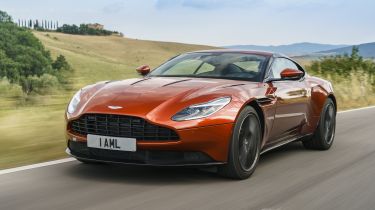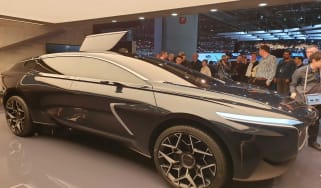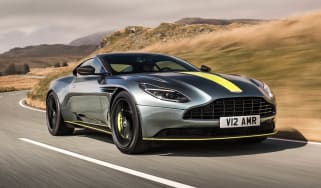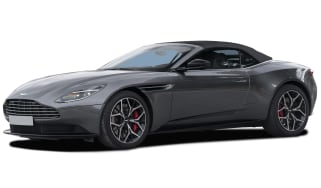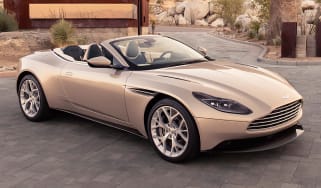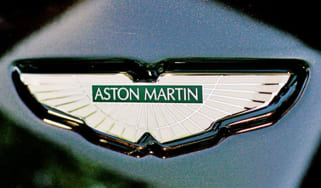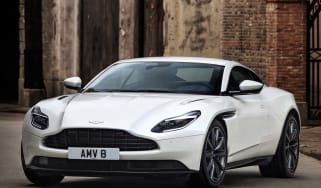Aston Martin DB11 coupe
"The stunning Aston Martin DB11 blends gorgeous looks with blistering performance and surprising comfort"
Pros
- Modern, luxurious interior
- Staggering performance
- Beautiful looks
Cons
- Small rear seats
- No manual gearbox available
- Expensive to buy, run and service
The Aston Martin DB11 represents a major departure in design and technology for the proud British brand. In true Aston style, the DB11 is billed as a ‘Grand Tourer’, able to convey its wealthy occupants across whole continents in inimitable style and with plenty of power in reserve.
It’s expected that the architecture beneath the DB11 will form the basis of more Aston Martin models, including an ultra-high-performance model and a luxurious crossover SUV that’ll arrive in the coming years. A V12-powered flagship sports coupe was the first to come from this platform, followed closely by a more affordable – although no less desirable – V8-powered version.
The latter found itself in the odd position of overshadowing its more powerful V12 brother – perhaps inevitable considering its use of the same twin-turbocharged V8 engine as the Mercedes-AMG GT. The smaller, lighter engine helped the DB11 V8 to feel more nimble, and also brought the price down, setting it against the Porsche 911, while the DB11 V12 took on the more expensive Ferrari Portofino.
The original V12 has been usurped by the DB11 AMR – named in tribute to the Aston Martin racing team. Its introduction has put more space between the V12 and V8 variants of the DB11, meaning they sit together more comfortably in the range. The AMR model heralds a more athletic edge to the V12 engine, as well as sharper responses and 30 extra horsepower, so drivers of the V8 model are no longer guaranteed to have the most fun. In fact, the Aston Martin DB11 can now count the Ferrari 488 among its competition.
More reviews
In-depth reviews
The AMR finally makes it worthwhile to stump up the extra money for the V12 engine, and its extra distinctiveness adds to its appeal. You can tell it apart from the V8 by its exposed carbon-fibre exterior trim, gloss-black highlights and the dark headlamp surrounds, together with its darkened rear lights. You'll also notice a dark grille and tailpipes.
With 630bhp on tap, the 5.2-litre engine effortlessly launches the DB11 AMR from 0-62mph in 3.7 seconds. Thanks to masterful suspension design, this power can all be deployed effectively, too, with the DB11 displaying remarkable finesse and agility considering its weight (it tips the scales at almost 1,800kg).
Previewed by the DB10 concept in the James Bond film SPECTRE, the DB11’s clean, simple lines represent a leap of faith for Aston Martin, whose cars have shared a single very distinctive look since the launch of the Vanquish in 2001. A long nose, low roofline and short rear overhang are the hallmarks of the brand and the DB11 takes these unmistakable proportions and combines them with wide, flowing curves and some very cleverly concealed features that improve the car’s aerodynamics.
The celebrated and instantly recognisable Aston front grille design is retained, but subtly updated, while the DB11 wears signature LED tail-lamps that are claimed to be the thinnest ever on a production car.
With all this performance potential, you may be surprised to learn that the Aston Martin DB11 has fantastic ride quality, far exceeding the comfort of its stiffer predecessors. It’s extremely well qualified as a Grand Touring car and the excellence of its passenger accommodation seals the deal.
Inside, Aston Martin has used real metal castings for the speaker grilles and air-vent surrounds and – although we weren't especially impressed with the quality we found in an early car, later examples we've driven are much improved. The interior design very is attractive, too – the designers have carefully judged their use of wood finishes to avoid tackiness or an old-fashioned look. It feels both simple and modern, and not overwhelmed by numerous gadgets and buttons.
That isn’t to say the DB11 is basic. Aston Martin worked with Mercedes during its development programme, so the car gets a version of the German brand’s excellent COMAND infotainment system, operated by a central rotary controller. Headlamps and wipers are operated elegantly from a single steering-column stalk. And if you hanker for more equipment, Aston Martin’s special ‘Q’ department can further tailor the car to your exacting requirements.
The DB11 is nominally a four-seater, indicating that Aston Martin took practicality seriously when designing this car, but the rear seats aren’t very accommodating and are best used by small children or to handle any luggage that won’t fit in the boot. They are ISOFIX-equipped, though, which is a thoughtful touch.
With prices starting at £145,000 for the V8 and over £170,000 for the V12 AMR, the DB11 is undeniably expensive. Fuel consumption is also high for both models, but that rather goes with the high-performance sports-coupe territory. The only real limitation is that the DB11 never quite stops feeling like a big car. For all its agility, its bulk might deter an enthusiastic driver from truly letting it off the leash. Otherwise, the DB11 is everything an Aston fan could hope for.

